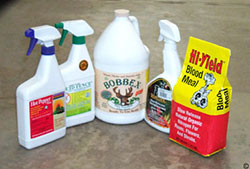 As people encroach further into deer habitat, deer naturally wander into lawns and gardens. While deer resistant plants are helpful, if deer persistently browse your landscape, you may need to use fence or deer repellents.
As people encroach further into deer habitat, deer naturally wander into lawns and gardens. While deer resistant plants are helpful, if deer persistently browse your landscape, you may need to use fence or deer repellents.
Wire mesh fences are more effective than wood, although not generally 100 percent effective. Vertical wire garden fences should be at least eight feet high. Slanted fences should lean away from the garden at a 30 to 45 degree angle from the ground and should be at least six feet high. This creates both a physical and psychological barrier to deer. Electric fences also can be used.
Fences protecting individual plants or small groups of plants should be at least four feet high. These enclosures are effective because deer avoid tight, penned-in sites. Garden netting may protect flowerbeds and other low-growing plants.
Tubes placed around the trunks of larger trees will help prevent some trunk damage, but not when bucks use the trees to scrape velvet off their antlers. Fencing trees may be needed.

Effective commercial repellents include Deer-Off and Deer-Away. One of the most effective homemade repellents can be made by whipping one part whole eggs with four parts of water. Apply on a dry day with temperatures above freezing. This egg spray does not readily wash away and is not harmful to plants.
Deer browse from the top of a tree or shrub to the bottom of trees and shrubs. Apply or hang repellents within the new growth. Young trees should be treated completely, but older trees may be treated only on the branch tips. In the fall and winter, treat trees six feet above the maximum expected snow depth. Re-apply the repellent every 30 days.
No repellent will be active forever and deer may get used to egg sprays. When this happens, try other measures and be persistent.
For more information, see the following Colorado State University Extension fact sheet(s).



